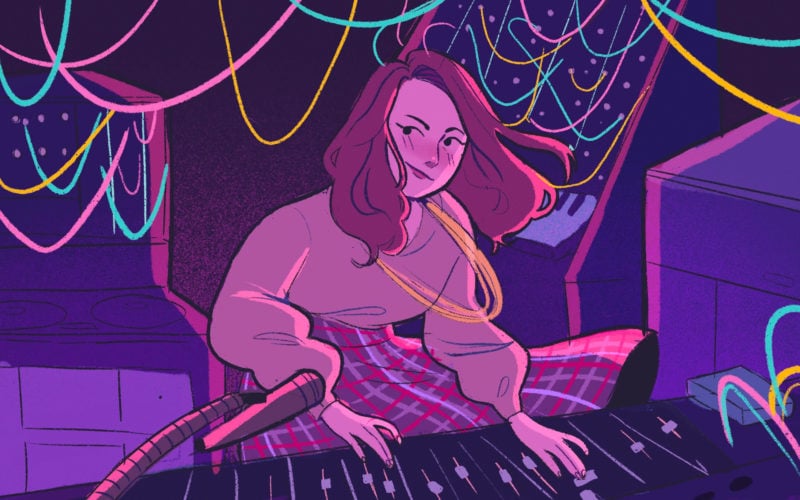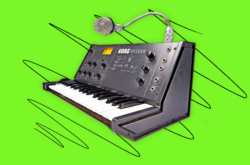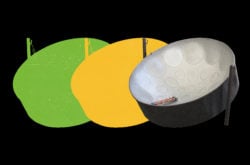Illustration: Abelle Hayford
It can be hard to pin down exactly when synthesizers made their way into mainstream music.
By the mid 80s, they were everywhere in pop, thanks to the widespread sale of the Yamaha DX-7. It carved a new lane for digital synthesis; 32 polyphonic presets were coded onto the synth’s hard drive, popularizing the bright, glassy tones of digital waves over the notorious warmth of analog synths. However, it was especially difficult to program since digital synthesis was still in its early stages. The interface was so complicated that just about everyone who got their hands on one stuck to its presets, hence the limited array of synth sounds that you can recognize in almost any 80s pop hit. For example, take a listen to Sade’s “Tar Baby” from 1985 – doesn’t that electric piano sound a bit familiar?
The 80’s didn’t birth synthesis, though; on Parliament-Funkadelic’s seminal 1975 album Mothership Connection, you can hear Minimoog riffs scattered throughout tracks like “Supergroovalisticprosifunkstication (The Bump-Bumps).” If we look even further back, you can hear more Minimoog on Sun Ra’s 1970 free jazz solo “Journey to the Stars.”
Clearly, we need to go even further back to tell the whole story; in order to find the point where synthesizers truly hit the ground running, we need to look at the success of Wendy Carlos’s debut album Switched-On Bach.
The early days of synthesis
But first, some context. Let’s rewind to the earliest days of synthesis and look at Raymond Scott (1908-1994), who founded Manhattan Research Inc. in 1948 to explore musical synthesis.
To call the machines built by Manhattan Research impressive would be a complete understatement; at the time, they were otherworldly and completely unheard of. In fact, much of the technology used in today’s synthesizers came directly from his work. After a successful career writing commercial jingles and big band jazz, Scott grew tired of dealing with his instrumentalists’ mistakes, and decided to build musical machines that would never mess up.
Some of these, like the aptly named Bandito the Bongo Artist, could compose basic rhythms and grooves on their own with only a couple knobs and buttons to create variation. Others, like his magnum opus, the Electronium, could do just about anything he wanted it to; it arpeggiated chords, wrote its own melodies, and drummed complex patterns. It was the most advanced synthesizer of its time, and it was the size of a massive desk. You can hear some of his best synthesized compositions, including the sample from J Dilla’s famous “Lightworks,” on Manhattan Research Project and many of his previously inaccessible works were recently released on the compilation Three Willow Park (a few of my personal favorites are “IBM Probe #4, “Mood Piece,” and any of his many versions of “Portofino”).
As Scott became more well known for his machines, he became friends with fellow inventor Bob Moog (1934-2005). Moog was developing similar instruments around the same time, so the two naturally formed a working relationship. Moog contributed parts such as VCAs and oscillators to many of Scott’s later synthesizers, and thanks to Scott’s advancements and breakthroughs, Moog was able to propel his own instruments in the market for other musicians. One of these musicians who got her hands on a Moog synthesizer would change the history of synthesis as we know it: Wendy Carlos.
Wendy Carlos
Wendy Carlos (1939 – present) was a trained and natural musician, learning the piano at age six and composing for woodwinds as early as ten. She studied music and physics at Brown University, teaching lessons in electronic music on the side. It was during this time that she met Bob Moog, and soon, she was helping him design and build the first commercially-available Moog synthesizer. In fact, it was Wendy who convinced Bob to add touch-sensitive volume control to his synths: a factor which was instrumental in advertising them as ‘real’ instruments. In return, she got some of Moog’s synths and began using them to compose jingles and pop songs to financially support herself.
Nearly ten years after she met Moog, she shared an old version of a Bach’s Two-Part Invention in F Major (recorded on one of Moog’s instruments) with her friend and business partner Rachel Elkind, who convinced her to pursue the concept more seriously. Thanks to Elkind’s previous experience as a record producer, Columbia Records granted the duo artistic freedom to pursue a synthesized album of Bach’s compositions as a part of their “Bach to Rock” sales campaign (this campaign, until including Wendy’s music, did not have a single modern rendition of any of Bach’s works planned).
Since the synthesizer could only perform one note at a time, the recording process was tedious. But, to say the least, it paid off. Switched-On Bach was the best selling classical album ever when it was released in 1968, and the first to go platinum. It put the synthesizer in a new light for the general public, and introduced it to many for the first time as a legitimate musical instrument. Thanks to its success, the Minimoog (released soon after her album) flew off of shelves nationwide.
It was in 1968 that Carlos also began hormone replacement therapy and started using the name Wendy. In a series of interviews published in the May 1979 issue of Playboy, she told the public about her transition. In the article, she described coming to terms with her gender identity as a very young girl, but as a people pleaser, learning to deny it publicly, despite her gender dysphoria. The interviewer repeatedly tried to unnecessarily bring sex and sexuality into the conversation, but she turned him down, refusing to be fetishized. In her own words, “my fantasies were more sensuous than sexual. Like cuddling. Or the love of silk or satin rubbing against my skin.” She talked about growth throughout her transition, feeling alone and even suicidal throughout most of her life, but finally feeling “peaceful and relaxed for the first time in [her] life” thanks to the changes that estrogen brought to her body. This was the first time that the public was educated about trans women, by a trans woman, on such a public scale. And, despite some dated terminology and disrespectful questions from the interviewer, Wendy handled it with grace. She explained the many changes that hormone therapy brings, talked about the grey area surrounding biological sex (a subject rarely discussed even today), and even advocates for use of the word “transgender” instead of “transsexual,” terminology that became commonplace a couple decades later.
Her transition gave her a sort of freedom that she hadn’t experienced before; she no longer felt trapped in the lie of living “as a man,” so she could pursue what she wanted to openly and proudly as herself (before transitioning, she had stopped performing live entirely because of the distress that being onstage in men’s clothes brought her). Hollywood quickly hopped on the synthesis wave, and in 1971, she was hired to score Stanley Kubrick’s sci-fi film A Clockwork Orange. This score brought new sounds to science fiction; the synthesizers she used were capable of creating futuristic sounds that people had never heard before, and audiences loved it. At one point in the film, she used a vocoder in a cover of Beethoven’s Ninth Symphony, which many credit as one of the vocoder’s breakthrough moments in the mainstream as well. She continued working on scores after this, combining orchestra, chorus, and electronics to create music for Kubrick’s cult classic The Shining and hallmark sci-fi film TRON, among others.
It should be noted that Wendy was not the first to compose an electronic film score – we have Raymond Scott’s work on Forbidden Planet to thank for that. It was entirely synthesized, unlike Wendy’s scores which incorporated acoustic instruments as well. Though, for a few reasons, Forbidden Planet never quite reached A Clockwork Orange’s level of fame. In her Playboy interview, Wendy also mentions drawing inspiration from the synthesized score of Close Encounters of the Third Kind.
After such breakthroughs, Wendy took a bit of a step back from the limelight, but she never stopped innovating. In many of her more recent compositions, she has explored concepts like alternate tuning systems, ambient music, and surround sound, never ceasing to explore the full potential of all sorts of musical concepts. In 1992, to celebrate Switched-On Bach’s 25th anniversary, she released an entirely re-recorded and reimagined version of the album with lots of extra material. She continued to build and modify her own instruments, just as she did in college with Bob Moog, even building a digital synthesizer long before the popularity of the previously mentioned DX-7. However, unlike Moog, she never sold them, as she “never thought of [herself] as having a whole lot of business acumen.” Rather, she devoted herself to her own work and her own happiness, and in doing that, solidified her status as an innovator and an icon.
Without Wendy Carlos, synthesized music as we know it would not exist. She shifted the musical landscape and inspired generations of young musicians after her, especially trans musicians, to forge their own path. Next time you watch The Shining or hear a Bach prelude, keep Wendy Carlos in mind.
Explore royalty-free sounds from leading artists, producers, and sound designers:
August 14, 2020



